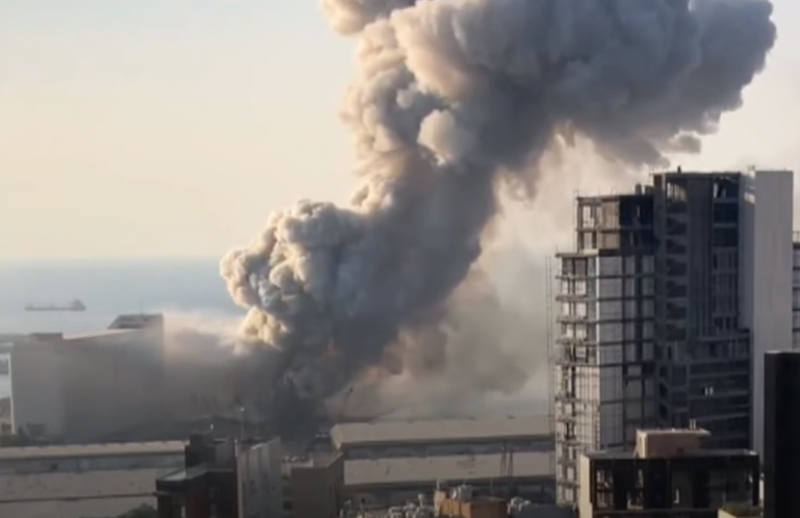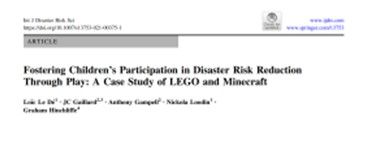You are here
Beirut Chemical Explosion
Beirut Chemical Explosion
On 4 August 2020, there was a big chemical explosion in Beirut causing at least 159 death, 6,000 injuries and 300,000 homeless as estimated on 10 August 2020. The explosion was caused by 2,750 tons of ammonium nitrate. The damage was equivalent to 3.3 magnitude of earthquake.
The estimated global production of ammonium nitrate is about 21.6 million tons in 2017. It is predominantly used in agriculture as a high nitrogen fertilizer. As ammonium nitrate is relatively very stable, it is mainly used as explosive mixtures in mining, quarrying, and civil construction. Similar formulations have been used in improvised explosive devices (IED) by terrorists.
Ammonium nitrate is a white crystalline solid with the chemical formula NH4NO3. Ammonium nitrate is stable at ambient temperature and pressure However, it may detonate from a strong initiation charge. Therefore it should not be stored near high explosives or blasting or combustible agents.
Although ammonium nitrate is relatively stable at room temperature, solid ammonium nitrate will decompose when heated. At temperatures around 300 °C, it will decompose into nitrous oxide (N2O) and water (H2O):
NH4NO3 → N2O + 2H2O
At high temperature above 300 °C, the following reaction predominates.
2NH4NO3 → 2N2 + O2 + 4H2O
It is important to note that both reactions are exothermic (release heat) and their products are mainly gases, especially oxygen. According to the media report, the fire and smoke were first caused by welding carried out by workers (Figure 1). Exothermic reaction will generate heat that produces more oxygen, which supports combustion and thus leads to a violent explosion. The appearance of red–orange colour explosion cloud (Figure 2) is caused by the existence of a secondary reaction product, nitrogen dioxide (NO2). Large stockpiles of the material can also cause a major fire and risk of explosion due to supporting oxidation which can be easily escalated to detonation. Various types of gaseous such as nitrogen, nitrous oxide, nitrogen dioxide, hydrogen cyanide and steam can be produced in detonation, leading to the formation of a big mushroom-cloud (Figure 3).

Figure 1: Welding sparkled fire and smoke

Figure 2: Orange color Nitrogen Dioxide explosion cloud

Figure 3: Large Mushroom cloud
The greatest detrimental effect is that explosion can cause primary blast injury. The powerful high energy wave travels at high speed. In addition to the physical injuries such as burn, fracture and wound, the blast wave will cause a sudden expansion and contraction to rupture air-filled body organs that contain gas such as lung, gut and the eardrum. Moreover, the blast wave will force air to penetrate into the blood vessel, causing the fatal gas embolism (air bubble inside blood vessel). The energy release in explosion is inversely proportional to the cube of the distance from the explosion source. The farther one stays away, the lesser the damage is.
The major challenge to the medical team will be safety as multiple explosions may happen. Moreover, toxic chemical hazard is another threat. The station of the medical team should be located at safe distance from the explosion site. Usually hot, warm and cold zones would be established according to the advice from the safety experts at the scene. If the medical team is not trained to don and doff appropriate personal protective equipment (PPE), they should only work in cold zone which is free from chemical hazards.
Ammonium nitrate is not hazardous to health and is usually used in fertilizer products. However, after burning or explosion, various types of toxic gaseous will be produced. Nitrogen dioxide (NO2), the orange explosion cloud, will usually be produced after chemical explosion of ammonium nitrate. Although NO2 is a well-known air-pollutant in our daily life from chemical factories, at high concentration of NO2 after explosion, it has corrosive property and will cause irritation to the airway and lung, producing bronchitis and pulmonary edema.
Chronic exposure to NO2 can cause respiratory effects including airway inflammation of healthy people and increased respiratory symptoms in people with asthma or chronic obstructive airway diseases. NO2 will be infinitely diluted in the atmosphere if there is no continuous gas production.
Dr. Jimmy Chan,
President of HK Association for Conflict and Catastrophe Medicine.
FHKAM(Surgery), FHKAM (Emergency Medicine)
Regional Director (HK), Advanced HazMat Life Support International, USA.
References:
1. Martel, B.; Cassidy, K. (2004). Chemical Risk Analysis: A Practical Handbook. Butterworth–Heinemann. p. 362. ISBN 1-903996-65-1.
2. Karl-Heinz Zapp "Ammonium Compounds" in Ullmann's Encyclopedia of Industrial Chemistry 2012, Wiley-VCH, Weinheim. doi:10.1002/14356007.a02_243
3. Ammonium nitrate sold by ton as U.S. regulation is stymied.Archived 28 February 2018 at the Wayback Machine – The Dallas Morning News
4. "The chemistry behind the Beirut explosion".
5. "Nutrient Content of Fertilizer Materials" (PDF). Archived from the original (PDF) on 24 December 2012. Retrieved 27 June2012.
6. Cook, Melvin A. (1974). The Science of Industrial Explosives. IRECO Chemicals. p. 1. ASIN B0000EGDJT.
7. Brook, Tom Vanden. "Afghan bomb makers shifting to new explosives for IEDs". USA TODAY.
8. Chemical Advisory: Safe Storage, Handling, and Management of Ammonium Nitrate United States Environmental Protection Agency
9. "Storing and handling ammonium nitrate" (PDF). Archived(PDF) from the original on 4 July 2011. Retrieved 22 March 2006.
10. Pradyot Patnaik (2002). Handbook of Inorganic Chemicals. McGraw-Hill. ISBN 0-07-049439-8.
11. "Ammonium nitrate". PubChem. Retrieved 6 August 2020.
12. "Ammonium Nitrate". webwiser.nlm.nih.gov. Retrieved 6 August2020.
13. Fertilizers Europe (2006). "Guidance for Compatibility of Fertilizer Blending Materials" (PDF).
14. Ammonium Nitrate-Regulating its use, Balancing Access & Protection from "Worksafe Victoria". Archived from the originalon 11 March 2011.
15. "Chemicalland21 – Ammonium Nitrate". Archived from the original on 10 January 2012.
16. "Material Safety Data Sheet, Ammonium nitrate MSDS".
17. Chaturvedi, Shalini; Dave, Pragnesh N. (January 2013). "Review on Thermal Decomposition of Ammonium Nitrate". Journal of Energetic Materials. 31 (1): 1–26. doi:10.1080/07370652.2011.573523.
18. "Lebanon's president calls for two-week state of emergency in Beirut after blast". Beirut. Reuters. 4 August 2020. Retrieved 4 August 2020. Aoun, in remarks published on the Presidency Twitter account, said it was “unacceptable” that 2,750 tonnes of ammonium nitrate was stored in a warehouse for six years without safety measures and vowed that those responsible would face the “harshest punishments”.








